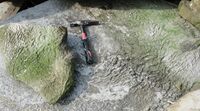Biology:Matground
Matgrounds are strong surface layers of seabed-hardening bacterial fauna preserved in the Proterozoic and lower Cambrian. Wrinkled matgrounds are informally named "elephant skin" because of its wrinkled surface in the fossil record. Matgrounds supported themselves until early burrowing worms were ubiquitous enough to unharden them.[1][2][3][4] Burrowing animals broke down the hardy mats to further penetrate the underlying sediment for protection and feeding.[5] Once matgrounds disappeared, exceptional preservation of lagerstätten such as the Burgess Shale or Ediacara Hills also did so too.[5] Trace fossils such as Treptichnus are evidence for soft-bodied burrowers more anatomically complex than the Ediacaran biota that also caused the matgrounds disappearance.[6][7]
See also
- Cambrian substrate revolution
References
- ↑ Ediacaran matground ecology persisted into the earliest Cambrian, by Luis A. Buatois, Guy M. Narbonne, M. Gabriela Mángano, Noelia B. Carmona & Paul Myrow, Nature Communications volume 5, Article number: 3544 (2014), publ. 28 March 2014
- ↑ Matground Structures and Redox Facies, by Friedrich Pflüger, Palaios 1999, V. 14, 25-39
- ↑ Ediacaran matground ecology persisted into the earliest Cambrian, Luis A Buatois, Guy M Narbonne, M Gabriela Mángano, Noelia B Carmona, Paul Myrow, Nature Communications, 2014 March 28;5:3544.
- ↑ Youtube video How Worm Holes Ended Wormworld, by PBS Eons.
- ↑ Jump up to: 5.0 5.1 Seilacher, Adolf; Luis A. Buatoisb; M. Gabriela Mángano (2005-10-07). "Trace fossils in the Ediacaran–Cambrian transition: Behavioral diversification, ecological turnover and environmental shift". Palaeogeography, Palaeoclimatology, Palaeoecology 227 (4): 323–356. doi:10.1016/j.palaeo.2005.06.003. Bibcode: 2005PPP...227..323S.
- ↑ "Life in the Cambrian". http://www.uni-wuerzburg.de/palaeontologie/Stuff/casu8.htm.
- ↑ Altermann, Wladyslaw (2002). Precambrian Sedimentary Environments. Blackwell Publishing. ISBN 0-632-06415-3.
 |


